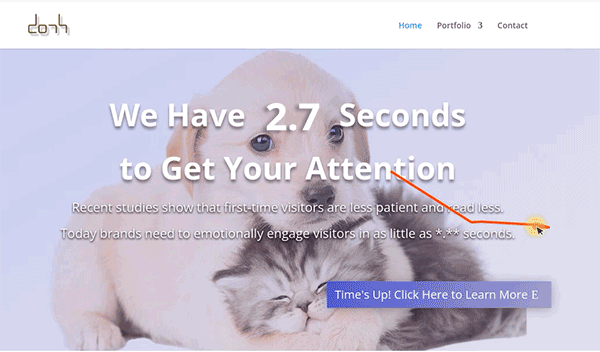Want to increase on-page click-throughs, top-of-funnel engagement and bottom-of-funnel conversions? Take a new look at your best performing keyword phrases and determine if they speak to customer pain. What new pain point keyword phrases might exist that are more related to customer intent? New content written to included these phrases will increase CTRs and conversions.
To start, list your highest engagement keyword phrases in a spreadsheet and add a column for “customer Intent.” Then think about each phrase individually and try to see if the phrase may have different intent than you think, or if there are new phrases that speak to customer intent you haven’t previously targeted. Really go deep into the demographic’s psychology (psychography) and rewrite your personas around pain points from your customer’s intent perspective.
Use this research and personas to write new content that speaks to customer pain, immediately engages visitors and increases conversions.

1 : the power or act of seeing into a situation: PENETRATION
2 : the act or result of apprehending the inner nature of things or of seeing intuitively
Customer insights explain behaviors around products and markets. Analyzing and reporting customer insights allows companies to:
- optimize their business model
- predict behaviors and buying patterns
- develop new features that drive sales and market share
- determine product functions that do not work, do not work well, or that could be eliminated to increase profit
- identify, predict and optimize buying-influence factors
Important, revenue-changing insight can be missed despite efforts of the most conscientious of marketing teams. By conducting customer interviews but also sending out email response requests and evaluating support requests, sales calls, testimonials for both you and your competitors, and evaluating what customers do by looking at what they search for on your site, how they interact with your website and/or your SaaS product, or evaluative measures or systems you can put in place to evaluate actual product usage all will arm your marketing team with insight for pain point messaging content development 95% of your competition will not have!
Qualitative Insights
This article discusses best practices and strategies for gaining qualitative and quantitative insights most companies miss. Conducting customer interviews, sending out email response requests and surveys, digging into the support request inbox, actually sitting in on and taking notes during sales calls and evaluating both negative and positive review content are the qualitative measures savvy marketers can take to evaluate qualitative data.
Customer Interviews
Email Responses
Support Requests
Sales
Calls
Customer Reviews
Competitor Reviews
Quantitative Insights
Quantitative analysis involves measuring actions customers take, and that sometimes measuring what they type. Measuring site search, website and product behavior can reveal important dichotomies that can deepen insight especially when customer behavior is in stark contrast to what they say.
Site Search
Website Usage Data
Product Usage Data
How To Gather Insights
 Start by creating a CUSTOMER INSIGHTS directory in a place you will be able to easily and continuously access. Then create subdirectories of each insight source and start collecting. Developing customer insight data is as straightforward as collecting note files, documents, spreadsheets, emails, recordings, testimonial copy and website usage and/or product usage analytics into appropriate directories in a shared space like Google Drive or Dropbox.
Start by creating a CUSTOMER INSIGHTS directory in a place you will be able to easily and continuously access. Then create subdirectories of each insight source and start collecting. Developing customer insight data is as straightforward as collecting note files, documents, spreadsheets, emails, recordings, testimonial copy and website usage and/or product usage analytics into appropriate directories in a shared space like Google Drive or Dropbox.
Customer Interviews
The product’s superior dissonance resolution is it’s USP in the marketplace, positioning it to win.
Thorough JTBD analysis probes to uncover customer challenges, frustrations, worries, anxieties, and pains in relation to the product or service. It asks for customer insight into available and possible solutions, what they’ve tried, and what they might envision. It probes for customer goals and desired optimum outcomes.
This thorough JTBD narrative is then used to conceptualize the product or service before it is designed and developed. Companies can save the most time and money being careful and thorough in this stage: conceptualizing a product based on JTBD data:
- promotes faster design and development by knowing detailed customer desires up front
- becomes less expensive than product development based on developer belief without market analysis
- building product prototypes or limited runs without JTBD data will multiply costs from concept to market
JTBD analysis profiles customer job friction and frustration pains to seduce and persuade prospects to buy.
Email Responses
Popular email survey best practices suggest developing an “engaging” subject line. However, it is more effective to develop subject lines that speak to customer pain. Engaging subject lines attract attention, but pain point subject lines offer higher psychological value and better survey results.
Product benefits in the subject line can achieve this better than generic “Your opinion matters. We want to hear your thoughts” subjects. Where it makes sense, try to create subject lines that speaks to detailed product use.
Use results can achieve pain point focus depending on the product. Asking about clean rugs instead of the vacuum cleaner can psychologically focus the prospect on the pain point dirty carpets present.
Support Requests
Both historical and current support email can yield valuable insights into common frustrations and product use issues. Spending even a brief time taking notes on commonly mention issues can drive traffic-magnet content development otherwise unattainable.
Sales Calls
Recorded or Live
After Covid drastically increased digital communications, often companies record some or all sales calls. Spending time taking notes through sales calls or recordings can uncover nuance and detail nothing else could.
True nature of win/loss exchanges
Hearing business development representatives on live phone calls with prospective clients as they discuss features, benefits and objections can powerfully impact marketing messaging in ways interviews or other method could not.
Competitor Insights
You can not only hear how product features resolve customer pain points, but also uncover those features that may not exist or are superior in a competitive offering that can be addressed to your advantage in nurture, win-back or promotional content.
Customer Reviews
- 360 degree comprehension of both good and bad review content
- Previously unknown or not featured product functions or uses customers are mentioning
- Article topics that focus especially on new or lesser known features
- Missing product perceptions or incorrect information found in negative reviews
- Holistic product use and feature need insight
A strategy that may be effective is to find ways to get especially positive reviews in front of incoming prospects coming to your website. There are social proof platforms that can leverage reviews from review platforms or from owned media sources.
Competitor Reviews
- Propose effective improvements users ask for
- Avoid wasting time trying to satisfy poor-fit customers
- Promote and maintain a satisfied customer base
- Provide management closed-loop insight into current operations
An important marketing task for competitive advantage is to monitor gaps in content and keyword phrase targets between you and your competitor(s). This analysis can also be done for earned content (testimonial) reviews.
Analyze your review content for use or other insights in testimonials both good and bad. Then dig into competitor reviews and note discrepancies especially between the severity of your negative review content compared to theirs.
These 360 views of testimonial content on all review platforms will broaden your perspective to then more closely target customer pain points in content development.
Site Search
If you have a fairly mature website, your traffic would or does perform searches for your content on it. This is increasingly common as CMS tools that have site search built in like WordPress become more widely used and consumers are increasingly finding and using it.
Local, on-site search reports are actionable by marketing teams as they:
- Reveals customer voice. Analyzing the queries people type into local site search can provide marketers clues into the terms customers use to identify and how they talk about JTBD tasks.
- Reveals keyword phrase priority. In one SaaS company their local site search history report showed terms they would never have considered and synonyms that that were missed.
- Reveals missing content. Seeing multiple instances of a term that is less than adequately covered can provide content calendar topics to increase website engagement. Often in-market traffic defines terms differently so some site content may need to be edited to more closely match customer voice.
- Reveals content popularity. Searching on site can indicate desire for more content in general. Site search is growing but relatively new and for especially sites with a smaller content footprint and/or low traffic, site search is a strong actionable indicator.
Site search implementation in GA4 is easy:
Log into your Google Analytics account, click Admin, click Account Views in the second column, then scroll down to ‘Turn On Site Search’ at the bottom.
Website Usage Data
Watching back-to-back sessions can show:

- Visitor reaction and interaction with website elements and features. Watching user recordings is a bit like watching yourself on video for the first time. The insight gained is unlike any other insight source.
- Mistakes in guessing optimum placement of content and graphics. Often website elements marketers and designers are sure have been placed optimally are not. Customers and prospects will never be able to tell you this verbally.
- Clues about where to structure or change conversion elements. When planning for optimization changes on pages with poor conversion, recorded session behavior can make needed changes obvious.
- Insight into frustrations visitors experience with your design. Noting “click rage” – the continuous clicking on an element or area by visitiors – can show you where to make immediate, conversion-lifting changes.
Insight can be captured by watching user sessions and simply taking notes. Optimally multiple stakeholders perform this on a regular basis and collaborate with their notes to create content calendar entries, website changes, landing pages for paid search campaigns and other bottom-of-funnel (BOFU) conversion improvements. Such content and UX improvements often achieve ROI lift by hundreds of percentage points.
Website Usage Data
Analyzing product or service use is critical to minimizing customer attrition and increasing LTV. Knowing predominant customer actions provides clear new feature development direction to improve loyalty and LTV.
- We never sell or share email addresses.
- Stays on same page.

